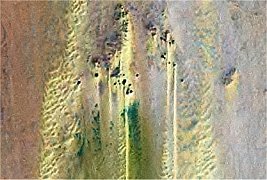

 |
"Hill with Stone Circles on Top" |
Some 80 kilometres to the East of the Gilf Kebir, there are a group of low sandstone hills that have built a series of long trailing dunes on their southern side. Before the dunes formed, the area to the south of the hills was a shallow depression that contained a large shallow lake that is clearly visible on the satelite photos as a dark patch surrounded by the dunes. The mud of the lake bottom has eroded into a series of Yardangs or mud lions. Their pink hue makes an incredible contrast with the golden dunes and the cobalt sky, making the spot one of the most picturesque in the Libyan Desert.
In neolithic times the lakeshore offered an excellent habitat, attested by the numerous implements and the remains of several hut circles on higher ground around the lake. Nearly all the hills have the remains of one or more circular stone features on their flat tops, probably shelters for prehistoric hunters who had an excellent vantage point to watch game come to the lake to drink. The best preserved are two large circles of fairly large blocks on the flank of a hill overlooking the deepest part of the lake, where water must have remained the longest. A notable discovery during one of our trips were a few microlith blades made of Libyan Desert Glass, more than 300 kilometres from the source of the raw material.
It is unclear who was the one to discover and name the place. Most probably it was Bagnold and company in 1938, as previous expeditions have apparently taken a more northerly, or more southerly route. The tracks passing by marked on the 1942 edition of the Survey of Egypt map seem to be those of the 1938 Bagnold expedition, and Bagnold himself mentions a series of "neolithic" lakes and mud lions along the way in his 1939 April Geographical Journal article.
During the 1996 season Rudolph Kuper and his team excavated the stone circles, and found within a cache of "Clayton Rings", mysterious pottery objects first reported by patrick Clayton during his 1931 Southwest Egypt Surveying Expedition. Since then, such objects have been discovered at a large number of localities, all in the deep desert away from wells and oases, even in the middle of the Great Sand Sea. They are truncated cones open on both ends, associated with flat discs with a hole in the middle. They have been dated to be contemporary with the pre- and protodynastic periods of the Nile valley (about 3000 bc.), by which time the Eastern Sahara was as arid and inhospitable as today. Nothing is known about their purpose, and who made them.
For an excellent summary of all we know about the "Clayton Rings" see:

|

|

|